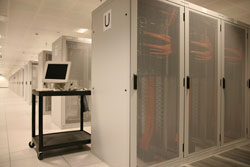In the search of fundamental particles
The search for new phenomena and the need for accurate measurements of particle physics processes formed the basis of the experiments under preparation for the Large Hadron Collider (LHC) accelerator in Geneva, Switzerland. Along with further verifying the "Standard Model" which governs the microworld, these experiments will search for new elementary particles - like the Higgs boson particle responsible for the phenomenon of mass. To enable scientists to find the Higgs boson or even search for new states of matter, such as the quark-gluon plasma, the collision rate will reach 10^9 events per second. The enormous amount of particles and derived information for each event will be partially filtered on-line, leaving nevertheless a large portion for recording and off-line analysis. The Global Resource Information Database (GRID) concept has been therefore recognised as a viable solution for the required computing infrastructure, offering a better sharing of resources and importantly, loads. The European collaboration of research institutes within the CROSSGRID project created the necessary "test-bed", a geographically distributed collection of computing resources for testing new developments in data pre-selection. All necessary computing resources were connected by fast networks and controlled by adequate GRID middleware, along with tools and software packages developed specifically for this purpose. In particular, a Polish physics group at Instytut Fizyki Jadrowej in Krakow built large farms of personal computers (PCs), accompanied by large storage systems for the ATLAS experiment event filter. Efficient interconnection of the Polish National Research and Education Network and the Academic Computer Centre Cyfronet with the European Organisation for Nuclear Research was available thanks to the GÉANT network. The main physics aim of the Polish computer cluster covered simulations of the ATLAS detector response to 50 thousands events of Higgs bosons decaying at 400GeV. This site validation procedure was based on processing test samples, event reconstruction at full granularity using the latest alignment and calibration data and subsequent comparison with reference results. The valuable experience gained in system architecture, data management and computing models will have considerable influence on future solutions to challenges posed by the LHC experiments.







